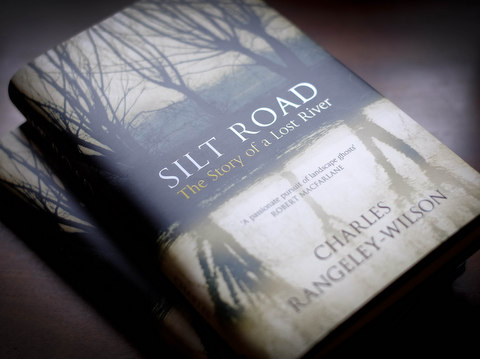It’s strange but not surprising how a single river can grip a fishing writer.
For many, or even most, it’s all about the idyll. For some of us, including many Wandle Piscators, the river that won’t let go is a far-from-obviously-idyllic urban stream. And for Charles Rangeley-Wilson, President of the Wild Trout Trust and a Patron of this club, that inverted idyll is the Wye…
… a little chalk river that rises in the Chilterns just west of High Wycombe and gets swallowed up by brutal ribbon conurbation long before it joins the Thames seven miles downstream at Bourne End.
All of Charles’ previous books have been anthologies: classic texts in Chalkstream: In Praise of the Ultimate River, his own collected essays in Somewhere Else and The Accidental Angler. So Silt Road feels very much like the full-strength personal testament he’s been working up to.
Loosely structured as a diary of repeated pilgrimages to (and through) the history and contours of the Wye valley, Silt Road tells how a chair-making boom town on the headwaters of a beautiful chalk river progressively debased and finally buried the waters that once gave it life.
The diary’s inner and outer landscapes reflect and reveal each other: darkness or unquiet sleep seem to overtake the author on almost every visit, inescapable emanations from the river, now culverted beneath the roar of the ever-present A40.
Much in the manner of WG Sebald – a subtle but clearly very important influence – the story builds in fascinating “concentric rings of growth” like the industrial heartland and housing estates of High Wycombe itself. Interwoven themes and excursions include dream sequences, geological stratigraphy, the workings of water meadows on the Herefordshire Dore, Sir Francis Dashwood and the Hell-Fire Club, Luddite rebellions, sacred springs, how trout got to Australasia, and the toxic rivers of the underworld.
Also in the manner of Sebald, black and white illustrations of all kinds are carefully placed within the narrative: in Charles’ own words, “you read up to and away from each image, so that they really work inside the text”. It’s a crafted, immersive approach, with a powerful cumulative effect… and you can only begin to imagine the agonies it must have given both writer and designers.
Full disclosure to anglers of all kinds – Silt Road comes highly recommended by this reviewer, but it isn’t exactly a fishing book. The few Wye trout that do make an appearance are much more ghostly and allegorical than corporeal and real – subliminal representations of the questions we all need to ask ourselves about our relationship with the landscapes we’ve created and sometimes have a chance to restore.
Since reading Silt Road, I’ve occasionally stopped to wonder whether Charles will finally be able to move on from his all-consuming fascination with the Wye, now he’s staked it to the printed page and planted a way-marker of landscape literature in the process.
But such is the grip of this little lost river… somehow I doubt it.
Silt Road: The Story of a Lost River has just been published by Chatto & Windus. Hardback, £16.99.
A shorter version of this review also appears in the current issue of the Wild Trout Trust’s annual journal, Salmo Trutta.

